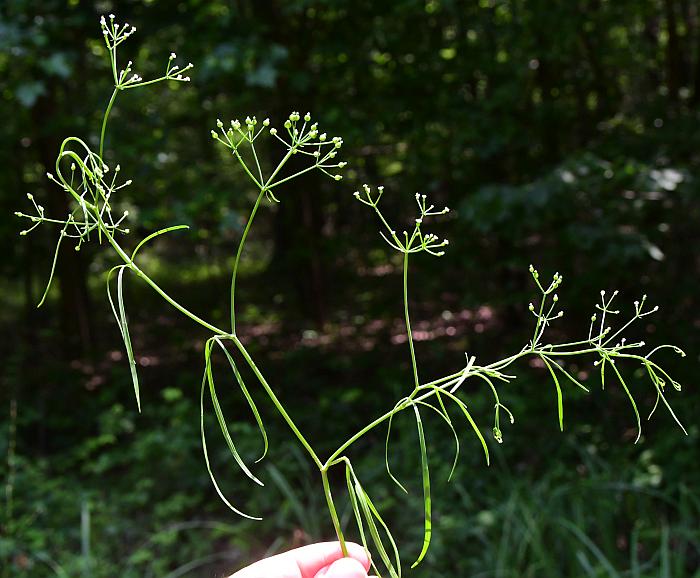Cynosciadium digitatum DC.
Finger Dogshade

Native
CC = 7
CW = -3
MOC = 8
SRank = S2
© SRTurner
Cynosciadium digitatum DC.Finger Dogshade | |
 |
Native CC = 7 CW = -3 MOC = 8 SRank = S2 |
© SRTurner |
|
Family - Apiaceae Habit - Annual forb. Stem - Ascending to erect, to 80 cm, usually branched, glabrous.
Leaves - Alternate and usually also basal, short-petiolate or nearly sessile, glabrous, the sheathing bases not or only slightly inflated. Leaf blades 2-15 cm long, the basal and lower stem leaves (rarely also the uppermost ones) simple, the median and upper leaves palmately compound with 3-5 leaflets, linear or narrowly elliptic (when simple) to broadly fan-shaped in outline, the leaflets 20-150 mm long, 1-6 mm wide, linear to narrowly elliptic, entire, gradually narrowed or tapered at the base and tip, with irregular, fine cross-septations.
Inflorescences - Terminal and axillary, compound umbels, short-to long-stalked or rarely sessile. Involucre absent or of 3-5 bracts, these 2-10 mm long, spreading to reflexed at flowering, entire, linear. Rays 2-10, usually unequal in length, 1-4 cm long, less commonly 1 or more umbellets sessile. Involucel absent or of 2-5 bractlets, these shorter than the flower stalks, entire, linear. Flowers 2-20 in each umbellet, the stalks 2-12 mm long.
Florets - Sepals minute teeth, sometimes slightly enlarged and ovate-triangular. Petals broadly ovate, rounded or bluntly pointed at the tip, white. Ovaries glabrous. Fruits - Schizocarps 2-3 mm long, broadly ovate-elliptic in outline, rounded at the base, tapered abruptly to a short beak at the tip, slightly flattened laterally, glabrous, dark brown with lighter ribs, each mericarp with 5 prominent, corky ribs, the dorsal and intermediate ribs relatively narrow and lacking wings, the lateral ribs broader than the others, with small, corky extensions over the commissures.
Flowering - May - June. Habitat - Swamps, bottomland forests, sloughs, streambanks, ditches, moist roadsides, margins of rice fields. Origin - Native to the U.S. Lookalikes - Limnosciadium pinnatum; broadly, many other species of Apiaceae. Other info. - This species is uncommon in Missouri, restricted mostly to a few counties in the Bootheel. Its main range is mostly confined to five states to the south and west of Missouri. The plant is easily recognized by its umbellate inflorescences of tiny white flowers, and interesting palmately divided leaves. The leaflets bear conspicuous cross-partitions, as clearly shown in the images above. This is a distinctive diagnostic feature of this species. Photographs taken at Otter Slough Conservation Area, Stoddard County, MO, 5-29-2020, and at Big Cane Conservation Area, Butler County, MO, 6-9-2023 (SRTurner). |